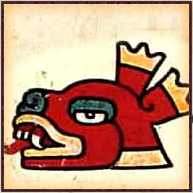
Dogs have occupied a powerful place in Mesoamerican folklore and myth since at least the Classic Period right through to modern times.[1] A common belief across the Mesoamerican region is that a dog carries the newly deceased across a body of water in the afterlife. Dogs appear in underworld scenes painted on Maya pottery dating to the Classic Period and even earlier than this, in the Preclassic, the people of Chupícuaro buried dogs with the dead.[2] In the great Classic Period metropolis of Teotihuacan, 14 human bodies were deposited in a cave, most of them children, together with the bodies of three dogs to guide them on their path to the underworld.[3]
The Xoloitzcuintli is a hairless dog from Mesoamerica. Archaeological evidence has been found in the tombs of the Colima, Mayan, Toltec, Zapotec, and Aztec people dating the breed to over 3500 years ago. Long regarded as guardians and protectors, the indigenous peoples believed that the Xolo would safeguard the home from evil spirits as well as intruders. In ancient times the Xolos were often sacrificed and then buried with their owners to act as guide to the soul on its journey to the underworld. These dogs were considered a great delicacy, and were consumed for sacrificial ceremonies – including marriages and funerals.[4]
In many versions of the 20-day cycle of the Mesoamerican calendar, the tenth day bears the name dog.[5] This is itzcuintli in Nahuatl, the language of the Aztecs, tz'i' in the Kʼicheʼ Maya language and oc in Yucatec Maya. Among the Mixtecs, the tenth day was taken by the coyote, ua.[6]
- ^ Burchell 2007, p.10.
- ^ Read & Gonzalez 2000, p.172.
- ^ Heyden 1998, p.26.
- ^ "Xoloitzcuintli Club of America, Inc. - ABOUT XOLOS". xoloitzcuintliclubofamerica.org. Archived from the original on 2019-01-07. Retrieved 2016-08-19.
- ^ Read & Gonzalez 2000, p.170.
- ^ Burchell 2007, p.25.